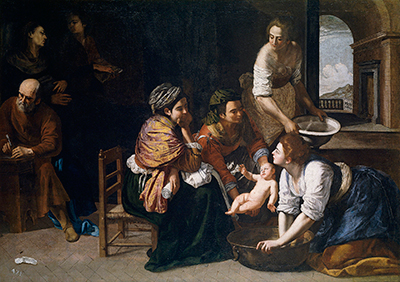Artemisia painted this masterpiece in Naples city for a cathedral and one can definitely see the baroque style of painting as she was living in the baroque era. Baroque style of painting was encouraged by artists such as Salvator Rosa who greatly inspired Artemisia.
This painting was among the six paintings which showcased the history of John the Baptist from the New Testament in the Bible. It was made for the Viceroy of Naples in Madrid. This painting showcased the anticipation of the feast of Nativity which ushers Christmas. This feast usually was celebrated through three masses and the people celebrating, Christians, rested on this particular day. Zechariah, the father of John the Baptist, is seen in the picture writing something which is supposedly the name of the child as he was struck dumb for not believing the message brought to him by God through Angel Gabriel. Elizabeth, the mother, is being assisted by Mary to hold after the child has been circumcised as per the traditions. We are able to make this conclusion as the child, john the Baptist has worn a white band.
Northern religious art is evident in this painting as the figurines in the painting are expressionless and dignified. This painting also has some Flemish Gothic style of painting as it was common in the 1600s to painting using this style. Although the figurines are expressionless and somewhat unreal there is still some realism in the scene depicted in the painting as the bright and dark colours used have blended well which shows that the chiaroscuro technique. They look as graceful as was thought of all saints. The theme of spirituality is evident in this painting as the figures are expressionless just as the way saints were seen by the world, they didn’t show any human emotion. The cloaks and draperies are all well depicted in the shadows skilfully.
The figures for this painting have realistic flesh tones which are impressive. Before painting this masterpiece, Artemisia used her skill of the art to showcase her pre-feminist beliefs and although this painting dwells more on the religious side, the female maids in this painting are emphasized more than other figurines in the painting and there is still some secular themes from this painting. She is always known for this character trait of putting women at the forefront of her painting to depict the message she wants to convey in a realistic way. This also shows that she was influenced by her father Orazio who respected and formed a friendship with Caravaggio.




